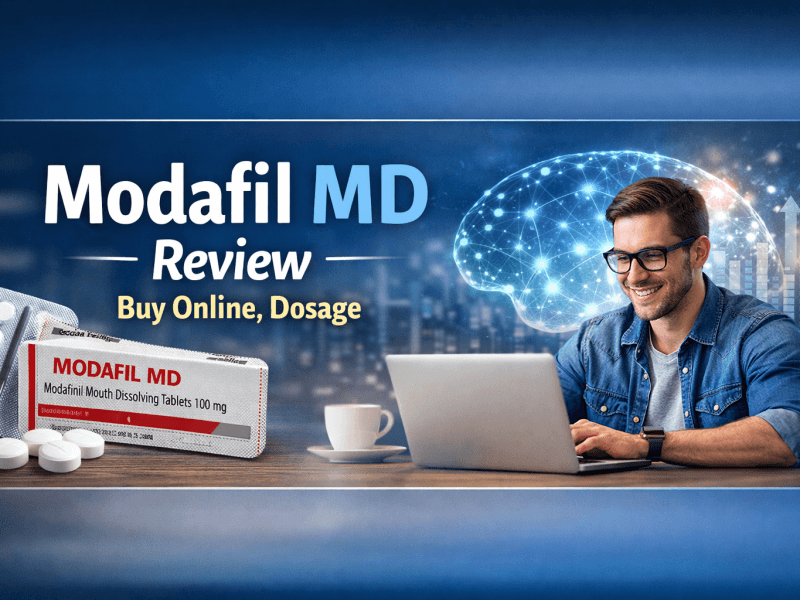Last Updated on 15/08/2025 by James Anderson
Introduction to Modafinil and Lexapro
Modafinil and Lexapro are two widely used prescription medications, each serving distinct purposes in mental and cognitive health. Modafinil is a wakefulness-promoting agent often prescribed for narcolepsy, shift work sleep disorder, or off-label for cognitive enhancement. Lexapro (escitalopram), on the other hand, is an SSRI antidepressant primarily used for depression and generalized anxiety disorder.
Although they work on different neurotransmitter systems, some patients may be prescribed both often for overlapping issues like fatigue linked to depression, or to counteract Lexapro related tiredness.
What is Modafinil?
Modafinil is a eugeroic, meaning it promotes wakefulness without the jittery stimulation of traditional stimulants. It influences dopamine, norepinephrine, histamine, and orexin systems in the brain. In the United States, it’s a Schedule IV controlled substance, indicating a low potential for abuse.
Key facts:
- FDA-approved for narcolepsy, shift work sleep disorder, obstructive sleep apnea related fatigue
- Off-label uses include ADHD, cognitive enhancement, and depression related fatigue
- Typical dose: 100-200 mg once daily, morning use preferred to avoid insomnia
What is Lexapro?
Lexapro (escitalopram) is a selective serotonin reuptake inhibitor (SSRI). It works by increasing serotonin levels in the brain, which helps regulate mood, anxiety, and emotional stability.
Key facts:
- FDA-approved for major depressive disorder (MDD) and generalized anxiety disorder (GAD)
- Off-label uses: panic disorder, OCD, social anxiety disorder
- Typical dose: 10-20 mg once daily, taken in the morning or evening
Why People Consider Combining Modafinil and Lexapro
While Modafinil and Lexapro are from different drug classes, they sometimes intersect in treatment plans.
Potential Benefits of Combination
- Counteracting SSRI fatigue: Lexapro can cause sedation or lethargy, which Modafinil may reduce.
- Improving cognitive function in depression: Combining may address both mood and motivation.
- Enhanced daytime focus: Especially relevant for patients with depression-related brain fog.
Common Reasons for Prescription Overlap
- Depression with fatigue
- Anxiety with cognitive slowdown
- Shift work disorder with comorbid depression
- Treatment-resistant depression (as adjunctive therapy)
Pharmacology and Mechanism of Action
How Modafinil Works
Modafinil has a complex, not fully understood mechanism. It appears to:
- Inhibit dopamine reuptake
- Increase norepinephrine and histamine signaling
- Stimulate orexin neurons to promote wakefulness
How Lexapro Works
Lexapro selectively inhibits the reuptake of serotonin (5-HT) into neurons, increasing its availability in the synaptic cleft and enhancing mood regulation over time.
Drug Interaction Overview
Possible Pharmacodynamic Interactions
- Both drugs affect brain neurotransmitters Modafinil indirectly influences serotonin; Lexapro directly increases serotonin.
- Theoretical risk of serotonin syndrome, though rare when Modafinil is combined with SSRIs at therapeutic doses.
Metabolism and CYP450 Enzyme Considerations
- Modafinil induces CYP3A4 and inhibits CYP2C19.
- Lexapro is metabolized partly by CYP2C19 and CYP3A4.
- Modafinil could slightly reduce Lexapro levels in some individuals.
Safety Concerns When Using Both
Risk of Serotonin Syndrome
While unlikely with standard doses, symptoms like agitation, confusion, sweating, and rapid heart rate should be taken seriously.
Sleep and Anxiety Impact
- Modafinil can cause insomnia if taken late in the day.
- Some people may experience increased anxiety from Modafinil, especially early in treatment.
Dosage Guidelines and Timing
Standard Dosages for Each Drug
- Modafinil: 100-200 mg in the morning
- Lexapro: 10-20 mg once daily
Best Practices for Combining Safely
- Take Modafinil in the morning to avoid sleep disturbance.
- Maintain consistent Lexapro dosing time.
- Monitor mood and anxiety changes weekly for the first month.
Side Effects to Watch Out For
Modafinil Side Effects
- Headache
- Nausea
- Dry mouth
- Insomnia
Lexapro Side Effects
- Nausea
- Sexual dysfunction
- Weight gain
- Fatigue
Combination Side Effects
- Anxiety
- Elevated heart rate
- Restlessness
- Mild mood swings
Who Should Avoid This Combination
- Individuals with uncontrolled high blood pressure
- Those with severe heart arrhythmias
- Patients with a history of mania or psychosis
- People highly sensitive to stimulants
Monitoring and Follow-Up
Doctors may recommend:
- Blood pressure checks
- Mood assessments
- Sleep tracking
- Periodic liver function tests
Expert Tips for Safe Use
- Start with the lowest effective dose of both drugs.
- Avoid caffeine overload Modafinil already boosts alertness.
- Keep a daily symptom journal.
- Report any unusual side effects immediately.
FAQ
1. Can Modafinil reduce Lexapro’s effectiveness?
Possibly, due to CYP3A4 induction, but the effect is generally mild.
2. Is it safe to drink coffee while on both?
Yes, in moderation, but monitor for jitteriness or insomnia.
3. How soon can I expect results from the combination?
Modafinil works the same day; Lexapro may take 4-6 weeks.
4. Can this combination cause weight loss?
Modafinil may reduce appetite; Lexapro can cause weight gain, so effects may balance.
5. What’s the biggest risk of combining them?
Anxiety exacerbation or rare serotonin syndrome.
6. Do I need to take them at the same time?
No. Morning for Modafinil, flexible timing for Lexapro.
Conclusion
Combining Modafinil and Lexapro can be beneficial for certain patients, especially those dealing with depression related fatigue or cognitive issues. While generally safe under medical supervision, careful monitoring is essential to prevent side effects and ensure optimal therapeutic outcomes.
‼️ Disclaimer: The information provided in this article about modafinil is intended for informational purposes only and is not a substitute for professional medical consultation or recommendations. The author of the article are not responsible for any errors, omissions, or actions based on the information provided.
References:
- Oliva Ramirez A, Keenan A, Kalau O, Worthington E, Cohen L, Singh S. Prevalence and burden of multiple sclerosis-related fatigue: a systematic literature review. https://doi.org/10.1186/s12883-021-02396-1 . 2021.
- Ciancio A, Moretti MC, Natale A, Rodolico A, Signorelli MS, Petralia A. Personality Traits and Fatigue in Multiple Sclerosis: A Narrative Review. Journal of Clinical Medicine. https://doi.org/10.3390/jcm12134518 . 2023
- Mereu, M., Bonci, A., Newman, A. H., & Tanda, G. The neurobiology of modafinil as an enhancer of cognitive performance and a potential treatment for substance use disorders. https://doi.org/10.1007/s00213-013-3232-4 . 2013
- U.S. Food and Drug Administration. PROVIGIL. U.S. Department of Health and Human Services. https://www.accessdata.fda.gov/drugsatfda_docs/label/2015/020717s037s038lbl.pdf . 2015
- Ballon JS, Feifel D. A systematic review of modafinil: potential clinical uses and mechanisms of action. J Clin Psychiatry. 2006
- Willavize, S. A., Nichols, A. I., & Lee, J. Population pharmacokinetic modeling of armodafinil and its major metabolites. https://doi.org/10.1002/jcph.800 . 2016
- ADHD: Clinical practice guideline for the diagnosis, evaluation, and treatment of attention-deficit/hyperactivity disorder in children and adolescents. https://www.ncbi.nlm.nih.gov/pubmed/22003063. 2011
- Arnold, V. K. A 9-week, randomized, double-blind, placebo-controlled, parallel-group, dose-finding study to evaluate the efficacy and safety of modafinil as treatment for adults with ADHD. Available at: https://www.ncbi.nlm.nih.gov/pubmed/22617860. 2012
- Clinical Pharmacology. Elsevier, Tampa, FL. Available at: https://www.clinicalpharmacology-ip.com. 2018
- Kakehi S, Tompkins DM. A Review of Pharmacologic Neurostimulant Use During Rehabilitation and Recovery After Brain Injury. Ann Pharmacother. 2021
- Barateau L, Pizza F, Plazzi G, Dauvilliers Y. Narcolepsy. Journal of Sleep Research. 2022


